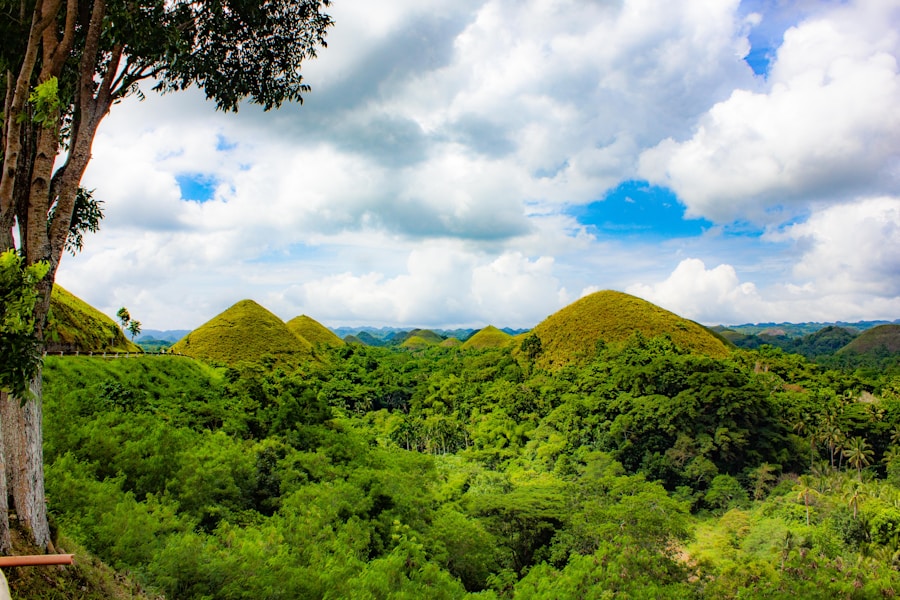Download links
How to install Discovering the Mystical Chocolate Hills of Bohol APK?
1. Tap the downloaded Discovering the Mystical Chocolate Hills of Bohol APK file.
2. Touch install.
3. Follow the steps on the screen.
Description
The Chocolate Hills, a geological wonder located in the Bohol province of the Philippines, are shrouded in local folklore and legend. One of the most popular tales recounts the story of two giants, Arogo and Aluya, who fell in love with a mortal woman. Their rivalry led to a fierce battle that resulted in the creation of the hills.
After their conflict, Arogo wept for Aluya, and his tears formed the lush green hills that eventually turned brown during the dry season, resembling mounds of chocolate. This romantic narrative not only adds a layer of enchantment to the landscape but also reflects the rich cultural heritage of the region. Another legend speaks of a giant who was known for his immense strength and his love for a beautiful maiden.
In this tale, the giant would often engage in battles with other giants, leaving behind heaps of earth and rock as he fought. Over time, these remnants transformed into the Chocolate Hills we see today. Such stories are integral to the identity of the Chocolate Hills, as they encapsulate the imagination and creativity of the local people.
These legends serve as a reminder of how natural wonders can inspire narratives that connect communities to their environment.
Key Takeaways
- The Chocolate Hills are a natural wonder in the Philippines, with a legend that tells of two giants throwing rocks at each other.
- The unique geological formation of the hills is a result of limestone weathering and erosion, creating over 1,200 cone-shaped hills.
- The surrounding area is home to a diverse range of wildlife and plant species, including the endangered tarsier and various bird species.
- Visitors can enjoy activities such as hiking, zip-lining, and ATV tours, as well as exploring nearby attractions like the Butterfly Conservation Center.
- Conservation efforts are in place to protect the Chocolate Hills and its surrounding environment, promoting sustainable tourism and preservation of the area’s natural beauty.
- When planning a trip to the Chocolate Hills, it’s recommended to visit during the dry season, bring sunscreen and insect repellent, and support local eco-friendly tour operators.
Exploring the Unique Geological Formation of the Hills
The Chocolate Hills are not merely a picturesque landscape; they are a remarkable geological formation that has intrigued scientists and geologists alike. Comprising approximately 1,268 to 1,776 hills, depending on how one counts them, these formations rise to heights between 30 to 50 meters. The hills are primarily composed of limestone, which has been shaped over millennia through a combination of erosion and weathering processes.
The unique conical shape of the hills is attributed to the dissolution of limestone by rainwater, which gradually erodes the softer materials while leaving behind these distinctive mounds. The formation of the Chocolate Hills is believed to have begun around two to three million years ago during the Pleistocene epoch. The area was once submerged underwater, and as tectonic activity raised the seabed, limestone deposits were formed.
Over time, geological processes such as erosion from rainwater and wind sculpted these deposits into the iconic hills we see today. The hills are particularly striking during the dry season when the grass covering them turns brown, creating a visual effect reminiscent of chocolate mounds. This seasonal transformation has contributed to their name and allure, drawing visitors from around the globe.
Wildlife and Biodiversity in the Surrounding Area

The region surrounding the Chocolate Hills is not only known for its stunning landscapes but also for its rich biodiversity. The area is home to various species of flora and fauna that thrive in this unique ecosystem. The hills are primarily covered with grasslands, but they also support a variety of trees and shrubs that provide habitat for numerous animal species.
Among these are endemic birds such as the Philippine tarsier, one of the smallest primates in the world, which can be found in nearby forests. This tiny creature is known for its large eyes and nocturnal habits, making it a fascinating subject for wildlife enthusiasts. In addition to tarsiers, the area is inhabited by various reptiles, insects, and mammals that contribute to its ecological diversity.
The Chocolate Hills are part of a larger ecosystem that includes rice fields, rivers, and forests, creating a mosaic of habitats that support different species. Conservation efforts in Bohol have focused on protecting these habitats to ensure that wildlife can thrive alongside tourism development.
Activities and Attractions for Visitors
| Activity/Attraction | Location | Visitor Count |
|---|---|---|
| National Museum | Washington, D.C. | 7 million |
| Central Park | New York City | 42 million |
| Disneyland | California | 18.7 million |
| Grand Canyon National Park | Arizona | 6.3 million |
Visitors to the Chocolate Hills can engage in a variety of activities that enhance their experience of this natural wonder. One of the most popular attractions is the viewing deck located at the top of one of the hills, which offers panoramic views of the surrounding landscape. From this vantage point, visitors can appreciate the sheer scale and beauty of the hills while capturing stunning photographs.
The experience is particularly breathtaking during sunrise or sunset when the changing light casts dramatic shadows across the hills. For those seeking adventure, hiking trails around the hills provide opportunities for exploration and physical activity. These trails vary in difficulty and length, catering to both casual walkers and more experienced hikers.
Along these paths, visitors can encounter local flora and fauna while enjoying the fresh air and scenic views. Additionally, some tour operators offer ATV rides through the surrounding countryside, allowing visitors to experience the landscape from a different perspective. Cultural experiences are also available, with local guides sharing insights into Bohol’s history and traditions, enriching visitors’ understanding of this remarkable region.
Conservation Efforts and Sustainability of the Chocolate Hills
As tourism continues to grow in popularity at the Chocolate Hills, conservation efforts have become increasingly important to protect this unique geological formation and its surrounding environment. Local government units and non-governmental organizations have initiated programs aimed at promoting sustainable tourism practices that minimize environmental impact while maximizing benefits for local communities. These initiatives include reforestation projects to restore native vegetation and protect wildlife habitats from encroachment.
Education plays a crucial role in these conservation efforts. Local communities are engaged in awareness campaigns that highlight the importance of preserving natural resources and biodiversity. By involving residents in conservation activities, there is a greater sense of ownership and responsibility towards protecting their environment.
Furthermore, sustainable tourism practices encourage visitors to respect local customs and contribute positively to the economy without compromising ecological integrity.
Tips for Planning a Trip to the Chocolate Hills

When planning a trip to the Chocolate Hills, timing can significantly enhance your experience. The best time to visit is during the dry season from November to May when the hills are at their most visually striking with their chocolate-brown hue. However, visiting during the rainy season can also offer a different perspective as the landscape becomes lush and green, showcasing another facet of its beauty.
Travelers should consider staying in nearby towns such as Carmen or Loboc for easy access to the hills while enjoying local hospitality. Transportation options include renting a motorbike or hiring a local guide who can provide insights into both the geological features and cultural significance of the area. It’s advisable to bring comfortable footwear for hiking and exploring as well as sun protection due to limited shade on some trails.
In addition to visiting the Chocolate Hills themselves, consider exploring other attractions in Bohol such as the Tarsier Sanctuary or Loboc River Cruise for a well-rounded experience.
By planning thoughtfully and being mindful of sustainability practices, visitors can enjoy all that this remarkable destination has to offer while contributing positively to its preservation for future generations.
FAQs
What are the Chocolate Hills?
The Chocolate Hills are a geological formation located in the Bohol province of the Philippines. They are made up of around 1,200 to 1,776 conical limestone hills, which are covered in green grass that turns brown during the dry season, giving them a chocolate-like appearance.
How were the Chocolate Hills formed?
The exact formation process of the Chocolate Hills is still a subject of debate among geologists. However, it is widely believed that they were formed by the uplift of coral deposits and the action of rainwater and erosion over millions of years.
What is the significance of the Chocolate Hills?
The Chocolate Hills are a major tourist attraction in the Philippines and are considered a natural wonder. They have been proposed for inclusion in the UNESCO World Heritage List due to their unique geological formation and stunning landscape.
Can visitors explore the Chocolate Hills?
Yes, visitors can explore the Chocolate Hills by climbing the viewing deck in the town of Carmen, which offers panoramic views of the hills. There are also hiking trails and ATV tours available for those who want to explore the area more closely.
Are there any legends or myths associated with the Chocolate Hills?
One popular legend about the formation of the Chocolate Hills involves two giants who engaged in a battle, throwing rocks and sand at each other for days. When they finally made amends, they left behind the mess they created, which eventually turned into the Chocolate Hills.





